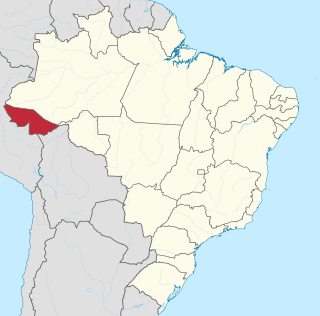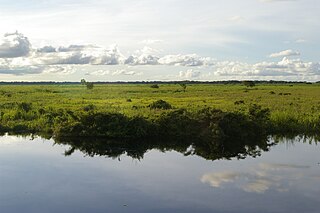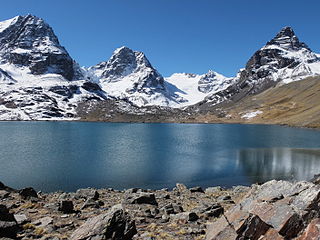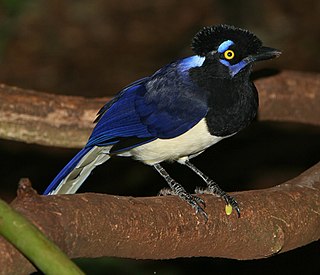Related Research Articles

Bolivia, officially the Plurinational State of Bolivia, is a landlocked country located in western-central South America. The constitutional capital is Sucre, while the seat of government and executive capital is La Paz. The largest city and principal industrial center is Santa Cruz de la Sierra, located on the Llanos Orientales, a mostly flat region in the east of the country.

La Paz, officially known as Nuestra Señora de La Paz, also named Chuqi Yapu (Chuquiago) in Aymara, is the seat of government of the Plurinational State of Bolivia. With an estimated 816,044 residents as of 2020, La Paz is the third-most populous city in Bolivia. Its metropolitan area, which is formed by La Paz, El Alto, Achocalla, Viacha, and Mecapaca makes up the second most populous urban area in Bolivia, with a population of 2.0 million, after Santa Cruz de la Sierra with a population of 2.3 million. It is also the capital of the La Paz Department.

The Chaco War was fought between Bolivia and Paraguay over control of the northern part of the Gran Chaco region of South America, which was thought to be rich in oil. It is also referred to as La Guerra de la Sed in literary circles, for being fought in the semi-arid Chaco. It was the bloodiest interstate military conflict fought in South America during the 20th century, between two of its poorest countries, both having previously lost territory to neighbors in 19th-century wars.

Acre is a state located in the west of the North Region of Brazil and the Amazonia Legal. Located in the westernmost part of the country, at a two-hour time difference from Brasília, Acre is bordered clockwise by the Brazilian states of Amazonas and Rondônia to the north and northeast, the Bolivian department of Pando to the southeast, and the Peruvian regions of Madre de Dios, Ucayali and Loreto to the south and west.

Beni, sometimes El Beni, is a northeastern department of Bolivia, in the lowlands region of the country. It is the second-largest department in the country, covering 213,564 square kilometers, and it was created by supreme decree on November 18, 1842 during the administration of General José Ballivián. Its capital is Trinidad.

Chuquisaca is a department of Bolivia located in the center south. It borders on the departments of Cochabamba, Tarija, Potosí, and Santa Cruz. The departmental capital is Sucre, which is also the constitutional capital of Bolivia.

The La Paz Department of Bolivia comprises 133,985 square kilometres (51,732 sq mi) with a 2012 census population of 2,706,359 inhabitants. It is situated at the western border of Bolivia, sharing Lake Titicaca with adjacent Peru. It contains the Cordillera Real, which reaches altitudes of 6.6 kilometers (4.1 mi). Northeast of the Cordillera Real are the Yungas, the steep eastern slopes of the Andes Mountains that make the transition to the Amazon River basin to the northeast. The capital of the department is the city of La Paz and is the administrative city and seat of government/national capital of Bolivia.

Santa Cruz is the largest of the nine constituent departments of Bolivia, occupying about one-third (33.74%) of the country's territory. With an area of 370,621 km2 (143,098 sq mi), it is slightly smaller than Japan or the US state of Montana. It is located in the eastern part of the country, sharing borders in the north and east with Brazil and with Paraguay in the south.

The Chapacuran languages are a nearly extinct Native American language family of South America. There are three living Chapacuran languages which are spoken in Rondônia in the southern Amazon Basin of Brazil and in northern Bolivia.

The Gran Chaco or Dry Chaco is a sparsely populated, hot and semiarid lowland natural region of the Río de la Plata basin, divided among eastern Bolivia, western Paraguay, northern Argentina, and a portion of the Brazilian states of Mato Grosso and Mato Grosso do Sul, where it is connected with the Pantanal region. This land is sometimes called the Chaco Plain.
An inland port is a port on an inland waterway, such as a river, lake, or canal, which may or may not be connected to the sea. The term "inland port" is also used to refer to a dry port, which is an inland extension of a seaport, usually connected by rail to the docks. This article covers only ports that are covered by the first definition.

Trinidad, officially La Santísima Trinidad, is a city in Bolivia, capital of the department of Beni. The population is 130,000.

Tacanan is a family of languages spoken in Bolivia, with Ese’ejja also spoken in Peru. It may be related to the Panoan languages. Many of the languages are endangered.

Madidi is a national park in the upper Amazon river basin in Bolivia. Established in 1995, it has an area of 18,958 square kilometres, and, along with the nearby protected areas Manuripi-Heath, Apolobamba, and the Manu Biosphere Reserve, Madidi is part of one of the largest protected areas in the world.

The plush-crested jay is a jay of the family Corvidae. It is found in central-southern South America: in southwestern Brazil, Bolivia, Paraguay, Uruguay, and northeastern Argentina, including southern regions of the Amazon Basin river systems bordering the Pantanal.

Pilón Lajas Biosphere Reserve and Communal Lands is a protected area in Bolivia located in the departments of La Paz and Beni, in their northern and western parts, respectively, about 350 km northeast of La Paz and 50 km west of San Borja. It lies largely within the Bolivian Yungas ecoregion. The main river that flows in the Pilon Lajas area is the Quiquibey River.

The Bolivian river dolphin, a mammal, is a species related to the Amazon river dolphin.

Quime Municipality is the second municipal section of the Inquisivi Province in the La Paz Department in Bolivia, located south-east of the city of La Paz. Its seat is Quime. The coordinates are 16° 59' 0" South, 67° 13' 0".
Warázu, also known as Pauserna or Guarasugwé (Guarasú'we), is a moribund Tupi–Guaraní language of Brazil. It was also formerly spoken in Bolivia. It is spoken by the Guarasugwé people, who were estimated to number 125 according to a census in 2012.
References
- Rand McNally, The New International Atlas, 1993.